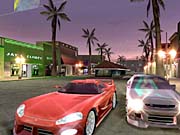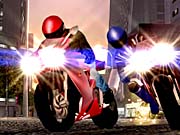Midnight Club II Designer Diary - Vehicles
We hear about the cars in Midnight Club II.
The Vehicles of Midnight Club II - 03/07/03
By Kouros Moghaddam
Lead Vehicle Designer, Rockstar San Diego
Designing the cars and bikes in Midnight Club II required a lot of research, which was great fun and meant that I was able to design the kind of heavily modified cars I wish I owned!

At least a month of development was put into the look of each vehicle. We started designing them by obtaining as much reference material as possible from real street racing. Southern California is a major center for street racing activity, and many of the staff members at Rockstar San Diego are car and bike fanatics, so there were a lot of ideas flying around. All the cars and bikes were inspired by real street racing machines and modifications, and tweaked further to get them exactly how we liked them. We created our own vehicles and aftermarket options, such as ground kits, hood scoops, NOS, and rims. The cars and bikes in Midnight Club II get very damaged, and even blow up when fully wrecked, so we did not make an effort to get licensed vehicles in the game. A lot of manufacturers do not want their cars or bikes to take damage in video games, and we could not be limited by that. The vehicles are continually modified and adjusted throughout development. The final versions of the vehicles are precisely detailed, with more than 5,000 polys each. Adding to the detail is a unique damage model for each panel of the car.
The control of the vehicles in Midnight Club II is the culmination of years of obsession with game physics. Midnight Club II presented a completely new challenge to us because of the unprecedented speed in the game. The goal was to provide a variety of fast, responsive high-performance cars and bikes. We are still tuning the vehicles on a daily basis, even after two and a half years of development. Each vehicle is tuned differently to 80 different parameters, including the basics like acceleration, top speed, auto/manual transmission, drive train (all-wheel drive, FWD, RWD), suspension, tire grip, and mass. There are also more-sophisticated, yet essential, parameters like angular inertia, friction, aerodynamics, downforce, and drag. All these parameters are physics-based algorithms that are not hard-coded, but are instead made to be adjustable in order for our programmers to constantly tune. The process of tuning a vehicle in Midnight Club II begins with the initial set up of the core parameters that will give you a drivable car or bike, such as mass, inertia, transmission, sliding, and power. Once the basics have been nailed down, we move on to primary tuning, which involves more-precise micro-parameters like suspension, steering, and acceleration. Beyond this, there is a third stage of tuning that includes aspects of the vehicles that are not directly associated with high-speed racing on the streets, like in-air controls, wheelies, and two-wheel driving.

Naturally, the development of the cars and the development of the bikes were very different and required different types of tuning parameters. Putting cars and motorcycles in the game to compete against each other was a technical challenge, mostly to make sure the gameplay is competitive and the play control for the bike corresponds to the one for the vehicle so the player's learning curve is as natural as possible. The bike handling requires more finesse, but the enhanced speed is balanced by sensitivity to collisions. Players who learn to control the bikes, especially the leaning to take very tight turns, will find a totally original, engaging, and addictive experience. Leaning and weight transfer are essential to control the bike. It is very easy to fall off the bike after a collision, so impact with the environment is something to watch out for.
The goal in developing the vehicles of Midnight Club II was to give gamers the machines they need to have a thrilling time racing in open cities. This means the cars and bikes not only look wicked but also have the ability to compete at very high speeds and perform insane stunts. Midnight Club II blurs the line between a racing simulation and a pick-up-and-play arcade-style racer. Gamers will have fun from the get-go, but they'll find that there is a lot to learn to get the maximum performance out of each vehicle.
Got a news tip or want to contact us directly? Email news@gamespot.com
Join the conversation